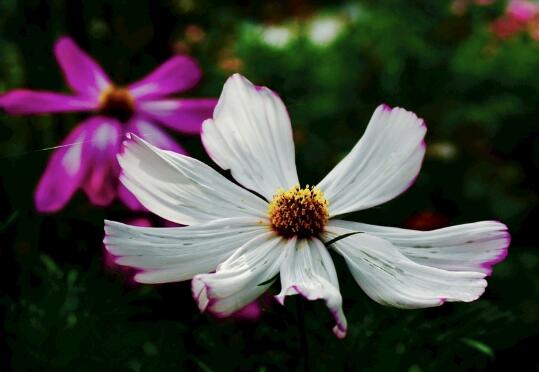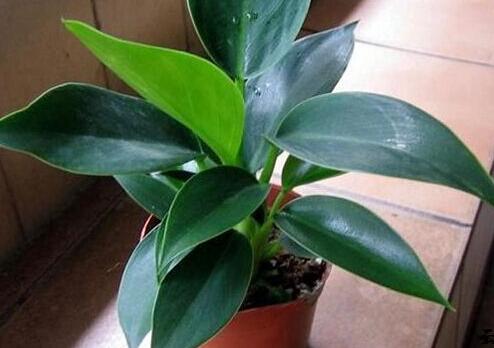How to water and fertilize Persian chrysanthemum, avoid stagnant water / fertilization and apply thin fertilizer frequently.
Persian chrysanthemum is a kind of flower plant native to America, and there are many people raising Persian chrysanthemum in our country, but there are many places that need to pay attention to if we want to raise it well, among which watering and fertilization is the most important. So how to water and fertilize Persian chrysanthemum? Next, the editor will take you to learn about it.
How to water the Persian chrysanthemum, along the edge of the flowerpot

About how Persian chrysanthemum is watered, in fact, the method is very simple. When watering Persian chrysanthemum, we can pour water into the soil along the edge of the flowerpot and stop watering when the soil has a certain degree of moisture. Remember not to accumulate water, otherwise it will cause its roots to rot.
1. Watering and watering when planting
Before planting Persian chrysanthemum, we need to water the soil, or cover the seeds with 1-2cm soil after planting, then soak the flowerpot in 1/3 of the water, let the water enter through the holes in the bottom of the flowerpot, and wait for the soil to become moist. Just pick up the flowerpot.
two。 Watering at the seedling stage and controlling the amount of water
After the emergence of Persian chrysanthemum seedlings, we should keep the soil at a certain humidity, which is conducive to its growth. When the climate is relatively dry, we can appropriately increase the watering frequency to prevent the soil from drying. But when watering, we should pay attention to control the amount of watering, and remember not to cause stagnant water, otherwise it is easy to cause rotting roots.
3. Watering during the growing period to keep the soil moist
After entering the growing period, Persian chrysanthemum has a great demand for water, and it is best to keep the surface of the soil moist all the time. If it is too dry, the soil will crack, so we should pay attention to this. Moisture is still very important to it.
Second, how to fertilize Persian chrysanthemum and apply thin fertilizer frequently
When it comes to how to apply fertilizer to Persian chrysanthemum, we need to pay attention to several points: first, fertilizer should not be applied to the plant, otherwise it is easy to burn the plant, which is generally applied to the basin soil, and the fertilizer needs to be diluted with water before fertilization. so that it can be better absorbed, if the direct application of thick fertilizer, it is easy to burn the plant.
1. Apply fertilizer before planting
Before we plant Persian chrysanthemum, we can first apply an appropriate amount of base fertilizer in the soil, so that the seeds can emerge more quickly, and after applying base fertilizer to enter the growth period, there is no need to apply fertilizer. If there is no base fertilizer before planting, regular fertilization is needed to enter the growth period.
two。 Fertilization during the growing period, once every 10 days
If the base fertilizer is not applied in the soil before planting, then we need to fertilize it regularly after entering the growing period, usually once every 10 days, not too much fertilizer, otherwise it is easy to make it grow too much. This will affect the number of flowers, which we should remember.
3. Matters needing attention in fertilization, high temperature taboo fertilization
When we are fertilizing the Persian chrysanthemum, if the ambient temperature is relatively high, it is best to stop fertilizing. When fertilizing at ordinary times, we should keep the balance of nutrients and avoid the phenomenon of heavy fertilizer and partial fertilizer. When fertilizing, you should be careful that the fertilizer is not too close to the root, otherwise it is easy to burn the root. Fertilization can be carried out with watering, but the amount must be controlled.
How to fertilize Persian chrysanthemum?
Time of fertilization:
The best planting time of Persian chrysanthemum is spring, and the best time of fertilization is spring.
Fertilization during planting period:
If the base fertilizer has been applied before planting, there is no need to apply fertilizer during the growing period. On the contrary, if you do not apply fertilizer before planting, you must apply fertilizer during the growing period.
Daily fertilization:
If no base fertilizer has been applied, appropriate amount of fertilizer should be applied during the growing period. in general, it can be fertilized once every 10 days. Fertilizer should not be too much, otherwise it is easy to cause the branches and leaves of Persian chrysanthemum to grow, which will directly affect the number of flowers.
Matters needing attention in fertilization:
1. Don't fertilize in an environment where the temperature is too high, or in the middle of summer.
2. When fertilizing Persian chrysanthemum, the nutrients in the fertilizer should be balanced to avoid the phenomenon of heavy fertilizer and partial fertilizer.
3. Avoid fertilizer being too close to the root of the plant when fertilizing, so as not to burn the root.
4. Topdressing can be carried out in the seedling stage, but we must pay attention to the balance of fertilizer nutrients, and do not apply too much fertilizer at the same time.
5. Fertilization can be carried out together with watering. But there must be no stagnant water.
Friends can also apply fertilizer according to their own actual situation, but be sure to control the balance of fertilizer and nutrients. In fact, the planting and breeding of Persian chrysanthemum is very easy. It is very suitable for beginners who love flowers but do not dare to grow them. At the same time, its ornamental effect is also very high. Beginners might as well start with Persian chrysanthemum.
How to raise Persian chrysanthemum, the breeding methods and precautions / sunshine of Persian chrysanthemum should be sufficient
Persian chrysanthemum is a kind of highly ornamental plant, which can be seen in many parts of our country. There are many people who raise it in our country, but if we want to raise it well, we need to pay attention to it. So how to raise Persian chrysanthemum? What are the breeding methods and matters needing attention of Persian chrysanthemum? Next, the editor will take you to learn about it.
First, how to raise Persian chrysanthemum and understand the habits
If we want to know how to raise Persian chrysanthemum, we must first understand its growth habits. Persian chrysanthemum is a light-loving plant, so we should maintain sufficient light when we breed it. In addition, watering, fertilization and other aspects also need to pay attention to. Details are introduced below, and we will move on.
2. Culture methods and matters needing attention of Persian chrysanthemum
1. Soil selection, good drainage.
In the breeding methods and matters needing attention of Persian chrysanthemum, choosing soil is the first step, and it is also a step to lay a good foundation. Only by choosing the right soil can Persian chrysanthemum grow more healthily. Persian chrysanthemum prefers to grow on loose sandy soil, which has good drainage and is not easy to accumulate water.
Note: the soil of Persian chrysanthemum should not be too fertile, otherwise it will have a certain impact on its growth, as long as the general soil has a certain degree of looseness.
two。 Fertilizer requirements, avoid big fertilizer
Persian chrysanthemum does not have a great demand for fertilizer during its growth. If there is a base fertilizer in the soil when we plant it, there will be no need to apply fertilizer after entering the growing period, because if we apply too much fertilizer, it will make the juice grow too much, thus reducing the number of flowers.
Note: if we release the flowers of base fertilizer in the soil before planting, the fertilizer must be diluted with water so that it can be absorbed, because this kind of plant is afraid of big fertilizer.
3. Watering requirements, small amount and more watering
Among the breeding methods and precautions of Persian chrysanthemum, watering is a point that needs to be paid attention to. This kind of plant likes water more. If the weather is dry, it should be watered 2-3 times a day, and once every 1-2 days when the climate is suitable.
Note: when we water the Persian chrysanthemum, we should remember to water a little more, keep the soil moist, do not water too much, otherwise it will easily cause the root of the Persian chrysanthemum to rot.
4. Lighting requirements, pay attention to shade in summer
Persian chrysanthemum is more like light, but can not bear strong light, if the spring and autumn sunshine is more suitable, we can keep it outdoors for a long time to receive light, but when the summer sunshine is too strong, we still need shade.
Note: we can move it to indoor semi-shade in summer, so that its growth will not be affected. In winter, on the contrary, we have to keep it indoors. Wait until noon when the temperature rises and receive 2-3 hours of light outside.
5. Timely prevention and control of diseases and insect pests
In the growth process of Persian chrysanthemum, if we do not maintain properly, it is easy to have some diseases and insect pests and other problems, this kind of problems do great harm to the plant, not only affect its ornamental, but also lead to the phenomenon of drying up and death.
Note: in the emergence of diseases and insect pests and other problems, we must deal with them in time, if the time is prolonged, it will be very difficult to cure, specific prevention and control methods you can refer to the Persian chrysanthemum pest control article, here the editor will not introduce too much.
- Prev

How to raise cosmos, cultivation methods and precautions of cosmos/sunshine should be sufficient
Cosmos is a highly ornamental plant, in many parts of our country can see its figure, there are many people who cultivate it in our country, but want to raise it well, there are many places to pay attention to. So how do you raise cosmos? What are the cultivation methods and precautions of cosmos?
- Next

How to trim the golden diamond, four pruning techniques to ensure the graceful shape of the plant / 3 key points to be paid attention to
When raising the golden diamond, in addition to fertilizing and watering, there is another step that can not be ignored, that is, pruning, because the golden diamond grows rapidly, if you do not pay attention to pruning, it is easy to appear steep length, dense intersection of branches and leaves, and so on, resulting in the plant shape is not beautiful enough.
Related
- Fuxing push coffee new agricultural production and marketing class: lack of small-scale processing plants
- Jujube rice field leisure farm deep ploughing Yilan for five years to create a space for organic food and play
- Nongyu Farm-A trial of organic papaya for brave women with advanced technology
- Four points for attention in the prevention and control of diseases and insect pests of edible fungi
- How to add nutrient solution to Edible Fungi
- Is there any good way to control edible fungus mites?
- Open Inoculation Technology of Edible Fungi
- Is there any clever way to use fertilizer for edible fungus in winter?
- What agents are used to kill the pathogens of edible fungi in the mushroom shed?
- Rapid drying of Edible Fungi

